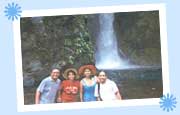The Philippine Star, Sept. 3, 2006
Bedazzled by Baler
By Christine S. Dayrit

I am a child of the universe as I synergize with nature and all its bounties. One of my most surreal experiences is walking barefoot on the shore, the cool water refreshing my feet, as the waves seem to whisper my name. I turn on my iPod and internalize my favorite Andrea Bocelli song, The Prayer, scrutinize the endless path before me, then close my eyes as I continue exhilarating walk. Inevitably, I hear the music so intensely that I seem to hear nothing at all. I have become the music. I realize that when I close my eyes, I see more.

I "see" this: along the sea-foamed ivory coast of Kinagunasan, birds hover in eerie flight, the crabs scamper into their burrowed holes, and the howling winds push the roaring waves to crash along the shore. Fishermen haul their nets, anchor their sea vessels, and tie the coconut trees to the ground. The elders genuflect before the saints in church as the town I crier rushes to warn the weary seamen. It is Dec. 27,1735, and the town is obliterated by a tsunami. The tide recedes without a sign of civilization: barren ground is littered with the dead, houses sheared clean by the rushing waves, and a small settlement inland, known here as the "Tromba Marina," is left with a few families survive. It is ominous to think that 269 years later, a tsunami of similar proportions ravaged nations in the peripheries of the Indian Ocean - Aceh a province in the island of Sumatra, Sri Lanka, and Phuket in Thailand - just hours before the anniversary of the 1735 Kinagunasan tsunami. Bizarre but true.

Gray skies did not dampen our cheery spirits when our chartered SEAir flight from Manila arrived at the Juan C. Angara Airport of Baler in Aurora Province. Soft drizzle fell, as we were given a warm welcome by Aurora Tourism officials. The rainy season in this province certainly brings fresh colors, flavors and dramatic sights worth experiencing. When the melodies of the northeast monsoon hum and the usual tranquil white beaches are transformed into deathtraps by angry swells, it is time for renewal because the rains bring forth new life and security when the land turns green, so fast. It is a feast for the eyes and soul.

Today, Baler is a gigantic symbol that offers its seafaring and mountain people a glimpse of what has long been in them: artistry tempered by patience and perseverance. For the people of Baler, theirs is a place truly blessed and smiled upon by providence> its soil serves as fertile ground for rice, coconut and citrus among other agricultural produce, and the famous sabutan plant, whose fibrous leaves make perfect handicraft like hats, bags and mats. Here, we discover some of the most delicious homemade products, like the peanut butter by Pacing Tolentino and the delightfully sinful Lyn's coco jam. Its waters are spawning with varieties of fish that feed the populace. As one enters the town proper, a time-warped character reveals itself. But looks are very deceiving. Baler has now become a favorite destination among businessmen who eye its agro-industrial and tourism capabilities. This unexploited town carved gained popularity as the setting for the surfing scene in the movie Apocalypse Now ("Charlie don't surf"!).

Balerians celebrated their town's 397th anniversary last Aug. 19, coinciding with the late Commonwealth President Manuel L. Quezon's 128th birthday. President Quezon was born here on Aug. 19, 1878. The Baler Day 2006 theme, "Bayang Pinagpala sa Masaganang Kalikasan, Pahalagahan, Pagyamanin, Pangunahing Adhikain (Town Blessed with Abundant Natural Resources, Nurture, Treasure our Main Aim)," is more than significant for a number of reasons.

Baler, founded in 1609 by Franciscan missionaries, has a rich cultural heritage, not only as the birthplace of Quezon, but also the last Spanish stronghold to surrender to Filipino revolutionaries. The conquistador Juan de Salcedo became the first European to visit this place as he explored its coast in the early 1570s. The Spaniards called it "Contra Costa" (Opposite Coast), lining it with forts and watchtowers that guarded against Moro pirates.
Baler town is also the center of festivities for the Philippine-Spanish Friendship Day, which is being celebrated on June 30 since 2003. On this day, the late President Emilio Aguinaldo decreed that the Spanish soldiers who surrendered during the siege of Baler in 1899 be treated as friends of the new Republic and granted safe passage back to Spain.

That the history and development of Baler should be so intertwined with the Angara family is almost a matter of destiny. The first Angaras of Baler came with Franciscan missionaries in the early 1700s. Senator Edgardo Angara's father, Juan C. Angara, fulfilled the role as father of Baler to an exceptional degree, so that one cannot say his name without mentioning the extent of his service to his hometown. He was a nurse, dentist, and a three-time mayor of Baler. The efforts of Juan C. Angara in Baler helped the residents survive threats of ignorance, disease, and even death at the hands of the Japanese. Survival seemed to be part of Baler and the Angara family; and it may have begun in 1735 when a tsunami devastated the old Baler town proper, known as Kinagunasan, and the Angara family was one of the few families that survived the tragedy.
Today, Baler is fortunate to have prominent leaders from this family. The dynamic Governor of Aurora Province, Bella Angara Castillo,. with support from brother Senator Angara and nephew Rep. Sonny Angara, is literally moving heaven and earth to provide the province with better infrastructure and basic services in livelihood, health and education. She is bent on converting Baler and the whole of Aurora Province into an agro-tourism center. Still in her first term, she has succeeded in mobilizing official development assistance from the South Koreans and Japanese who are among the best sources of agribusiness technology.

